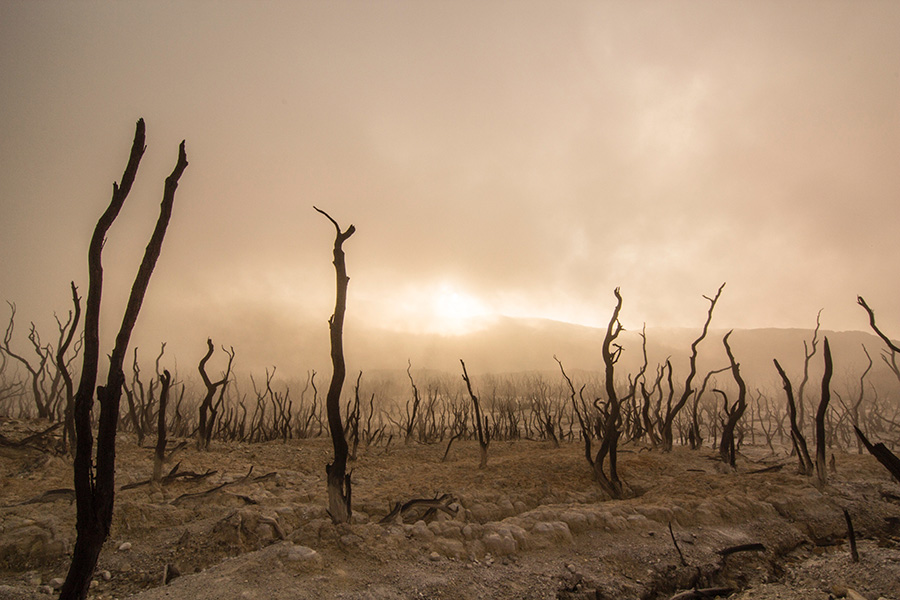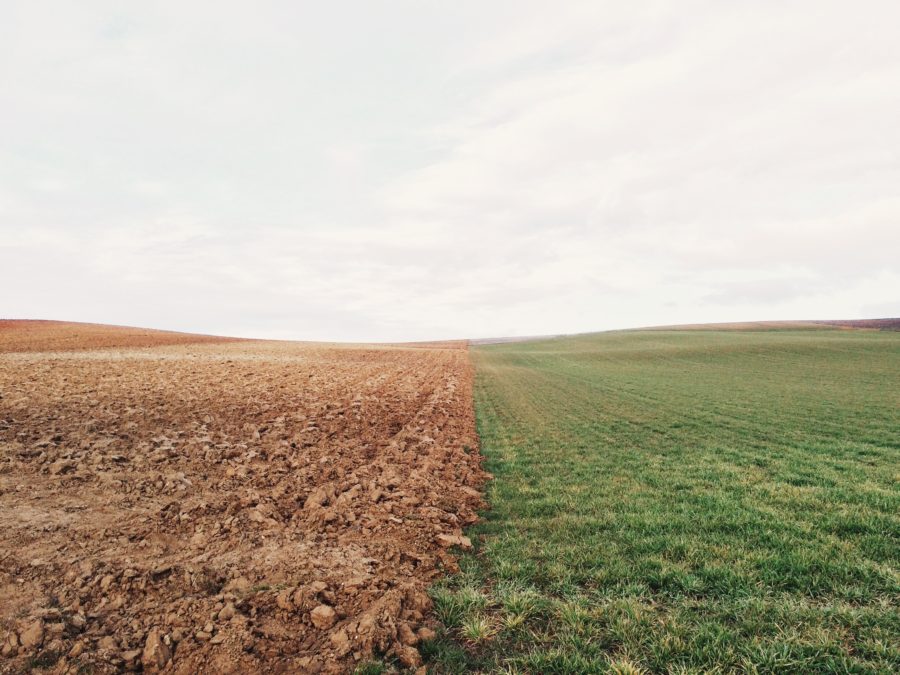Welcome to part two of my three-part blog series on the psychology behind climate change. Part two focuses on waking up to the urgent threat runaway climate change presents to our planet and our species. If you haven’t read part one, I encourage you to do so. Now, take a deep breath, calm your yourself, and see if you can open your heart and mind to the information that follows.
For those of you who have seen the HBO TV series Game of Thrones a strong analogy can be drawn from the plight of the people of Westeros and the global threat of climate change we face today. Permit me to “nerd out” for a minute as the analogy is quite compelling (warning: to avoid spoilers skip the next paragraph).
Here’s the situation: While everyone is consumed by the political division and fighting over control of the Iron Throne, a much greater threat is descending upon us . . . “summer is coming.” A few people who have actually been north of the wall and have experienced the threat first hand (think arctic climate researchers) believe it and are trying to convince the leaders of Westeros, but most ignore the warnings. The cause is righteous and real, however, because of the history of division and bad blood that runs through the fabric of Westeros, most are too consumed with the smaller fights in front of them and focused on their differences to see the threat for what it is. Well, I’m here to tell you THE WHITE WALKERS ARE REAL, and it’s called climate change. This common threat presents both the possibility of tearing apart the fabric of our civilization and an opportunity for the uniting of humanity, the likes of which we have never seen. Not convinced? Read on . . .

The Doomsday Scenario: Runaway Climate Change
Someone once said to me, “If you can get climate change onto my top five immediate concerns, I will probably take real action.” I think this is a good point. However, despite that fact that many experts think climate change should be the number one concern of humanity, getting onto the top 5 remains a difficult task. I’ve been asking myself a lot lately, “How does one wake somebody up to the urgent threat of something they’ve been hearing about for 25 years?” Despite the incredible amounts of irrefutable scientific data piling up to support reality of the threat human-made climate change presents, it remains background static for most in the United States. Hearing about climate change and the various problems it poses has become commonplace. Despite record highs across the country, more and more destructive storms, and wildfires raging in December, to most, climate change is still just something people debate the very reality of on TV. The task is to take something that has become commonplace and wake people up to the urgency of action that is required. One way to shock people out of their slumber is with the real life doomsday scenario of runaway climate change.
Reexamining Our Climate Change Beliefs
Take a moment to consider what picture you hold in your head about the impacts of climate change. My guess is that it looks something like average global temperature rising by a few degrees over the next 50 years and a gradual sea level rise punctuated by more and more intense storms, which primarily affects low lying coastal areas and disproportionately impacts the poor. Even for those who fully agree with the science of climate change, this is often the picture. However, the actual outcome could be far far worse and deeply impact every single human being on earth.
No one is immune from the effects of climate change.
Yes, the one thing climate scientists all seem to agree upon is that as global temperature averages rise, the sea will rise with it. In fact, the rise is happening faster than predicted. However, the earth’s climate is incredibly complex and even the best computer climate models can’t predict with any degree of certainty how factors like changes in deep ocean currents and acidification, cloud cover, and melting ice sheets, will interact as climate feedback loops. What is even more concerning is that most climate models assume we will develop technology that lets us remove billions if not trillions of tons of CO2 from the air in the near future, which is a huge gamble. If we are unable to take effective action to reduce CO2 in the very near future we may be faced with the unmanageable situation of runaway climate change.
In a nutshell, runaway climate change is what would follow the theorized tipping point in earth’s climate where the accumulated effects of human-made climate change initiate a reinforcing positive feedback loop creating rapid and destabilizing changes. If the tipping point is reached there is likely little humans can do to reverse the process before catastrophic events occur. The window of effective action on climate change is closing fast. Crucial milestones continue to be crossed. CO2 levels hit 400 parts per million (ppm) in 2015. The last time CO2 was this high was around 3 million years ago during middle Pliocene, which saw arctic temperatures around 14 degrees higher than they are now. A growing number of scientists theorize we only have a few years to take effective action in order to stop the worst of the effects of climate change. Some even argue that we have already reached that point. However, I and the majority of scientists believe we not there yet, though we are flirting with incredible destruction.
Pushing Us Over The Cliff: The Methane Burst
Of all the runaway climate scenarios, an arctic tundra methane pulse is by far the most frightening. Climate science tells us that when the climate changes slowly as it has over much of the history of our planet, species tend to adapt. However, when it moves quickly, as in the Permian mass extinction, “The greatest challenge life on Earth faced in its geologic history,” the life support systems of our planet collapse and species die out. The Permian mass extinction, which saw 90% of the earth’s species die off and the earth plunged into chaos for about 15 million years, happened because of the release of methane from the arctic in what is known as a methane pulse. Methane is roughly 30 times more powerful a greenhouse gas than CO2 and there is a whole lot of it stored in the arctic—around 10,000 gigatons to be exact—and it has the power to create truly terrifying destruction.
In an article published in the scientific journal Paleoworld in 2016 the authors state that,
“Global warming triggered by the massive release of carbon dioxide may be catastrophic, but the release of methane from hydrate [its frozen state] may be apocalyptic.”
They go on to note that a “methane pulse” over just a 10-15 year period was likely one of the central contributing factors of the mass extinction at the end of the Permian that wiped out 90% of life on earth and saw global average temperatures rise to 84.0°F. As a comparison the average global temperature is now only 59.0°F. This type of apocalyptic climate change has happened in earth’s history. The big question now is, “Are we currently on course for it to happen again?” Professor Peter Wadhams, head of the Polar Ocean Physics Group at Cambridge University, believes that CO2 driven climate change could trigger a major methane pulse, stating that this “threat is very real and very serious and has been disregarded a lot by the Intergovernmental Panel on Climate Change.”
Methane induced runaway climate change would not simply cause a disruption to human life and the global economy, it would, for the majority of us, end it. Additionally, it might not take a lot of warming to trigger a methane pulse, and things could happen very fast. Martin Kennedy, a professor at UC Riverside, and lead author on an article published in the journal Nature on the topic of methane’s role in climate change, states a climate change induced methane pulse “is a major concern because it’s possible that only a little warming can unleash this trapped methane . . . [which] could potentially warm the Earth tens of degrees, and the mechanism could be geologically very rapid.”
Just how likely is this doomsday scenario? The answer is we don’t know. There is unfortunately not yet any real scientific consensus on the issue largely because we don’t have accurate measures for how much methane is currently being released from the arctic. There is some evidence suggesting it has already begun. Within the last few years methane blowhole craters have started appearing all over the Siberian tundra, the cause of which is theorized to be the warming of the tundra.

Based on the increase in methane being released in the arctic, there are a growing number of scientists that are starting to become concerned. Jim Kennett, a professor of geology and paleobiology at UC Santa Barbara, believes that,
Finding climate triggers and tipping points has become the most important scientific problem of our time.
Even if the odds are low that the tipping point to runaway climate change will be reached in our lifetimes, do we truly want to gamble with the only home we have? A better question might be, if our planet’s ability to support life is truly at stake why haven’t we already done something about it? For some insights into this, let’s again take a look at our evolutionary heritage.
The Consumption Conundrum
Evolution itself is often misunderstood. Many people think that evolution is always leading somewhere better, smarter, more complex, but the truth is that it can actually lead to strange outcomes and even extinction. Australian Laureate Fellow Hanna Kokko, from the Research School of Biology, notes that the irony of evolution is that the short term benefits are often in conflict with the long term gains of a species. One of the simplest examples in nature is the algal bloom. This is when a large amount of nutrients are released into a body of water, say from fertilizer runoff, and everything that eats the algae has a field day, eating, procreating and eating some more. Then when the resource is gone there are too many fish, etc, and not enough food, i.e.–carrying capacity for the ecosystem has been exceeded. A mass die off ensues. If the entire species is endemic to that one body of water and there is a drought that summer then they are now in danger of going extinct as everyone is competing for scant resources. Though we may think of ourselves as “more evolved,” humans have demonstrated much the same exploitive behavior as almost all organisms on earth, and on a truly global scale since the industrial revolution.

Imagine our hunter gatherer ancestors over hundreds of thousands of years living transient lives, moving with the seasons, and living off of what they find. With transient populations of 20-50 individuals there must have been little concern over the exhaustion of resources. It was only about 10,000 years ago, with the agricultural revolution, that humans started to stockpile and plan ahead, but even then likely only years and not generations ahead. 10,000 years is a small blip in time compared to our 200,000-300,000 years spent as hunter gatherers, and our physical brains have not had time to catch up. As far as the brain is concerned, we have suddenly been dropped off in modern times and we’re trying to make sense of things. Suddenly overconsumption and exceeding the carrying capacity of the earth has become a reality, but short term gains still have a very strong pull. Kokko explains, “A fisherman gets away with catching too many fish without negative side effect during his individual lifetime. While a cooperative and conscious fisherman does not get the future profit of a better long term fish supply.” Influenced by our brain’s hardwiring, many have and continue to choose short term gains over long term viability. Put simply, humans are pretty bad at long-term planning, mostly because it didn’t contribute enough of a competitive advantage through most of our evolution. Just consider all the industry in the last 200 years that has revolved around the extraction and depletion of natural resources. Our hardwiring says “When you find a good resource exploit it,” but this way of being has for the first time in history reached a global breaking point.
We are stealing from future generations in order to pay ourselves today. This puts the fate of our species and many others at great risk.
The face of the earth has completely changed since the industrial revolution. Fossils fuels are our algal bloom. Whether fossil fuels simply start to wear thin and destabilize our global economy or they warm our planet so much that it becomes unrecognizable and even uninhabitable, we are headed for trouble. If we want to avoid the follies that our ancient brains are unwittingly leading us to, then we have to consciously decide to change course. We have to update the software and we have to learn and teach new ways of being that integrate foresight, harmonious relationships with nature, and true long-term planning for the good of all. Given enough time, I have a lot of confidence that humanity can and will figure this out. However, humanity has little time left for effective action. The true conundrum of climate change is that when we start to feel the real destructive force of a shifting climate it will be too late to change course. We must do the impossible and, without directly experiencing the destruction ourselves, act swiftly, decisively, and globally, to protect our future selves and future generations from this impending crisis.
Don’t Worry, It’s Normal to Feel Overwhelmed
If reading this has left you with an acute feeling of anxiety or hopelessness, don’t be discouraged! This is an appropriate reaction to confronting the crisis we face as a species. It is overwhelming to face the fate of humanity isolated and alone. Of course so many feel discouraged. But, if possible, don’t reject these feelings. Instead use them. Reach out to others, link arms, and take action in some way. Part three of this series looks at what exactly you can do to get free from the bondage of disempowerment and hopelessness, and lays out steps you can take to make a difference. Ultimately, I see climate change not just as a huge threat, but also as the greatest opportunity humanity has ever had to come together, set aside our differences, and work toward a common goal. Thank you so much for reading and being willing to face this difficult and even terrifying reality. We can’t do this alone but together we can, and we must.
Dan Entmacher M.A., LPC
Photo by elizabeth lies on Unsplash

